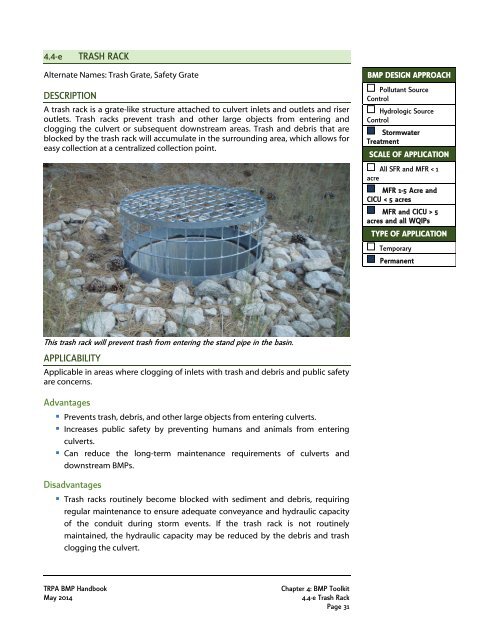4.4-e TRASH RACK DESCRIPTION APPLICABILITY ... - Tahoe BMP
4.4-e TRASH RACK DESCRIPTION APPLICABILITY ... - Tahoe BMP
4.4-e TRASH RACK DESCRIPTION APPLICABILITY ... - Tahoe BMP
Create successful ePaper yourself
Turn your PDF publications into a flip-book with our unique Google optimized e-Paper software.
<strong>4.4</strong>-e<br />
<strong>TRASH</strong> <strong>RACK</strong><br />
Alternate Names: Trash Grate, Safety Grate<br />
<strong>DESCRIPTION</strong><br />
A trash rack is a grate-like structure attached to culvert inlets and outlets and riser<br />
outlets. Trash racks prevent trash and other large objects from entering and<br />
clogging the culvert or subsequent downstream areas. Trash and debris that are<br />
blocked by the trash rack will accumulate in the surrounding area, which allows for<br />
easy collection at a centralized collection point.<br />
<strong>BMP</strong> DESIGN APPROACH<br />
Pollutant Source<br />
Control<br />
Hydrologic Source<br />
Control<br />
Stormwater<br />
Treatment<br />
SCALE OF APPLICATION<br />
All SFR and MFR < 1<br />
acre<br />
MFR 1-5 Acre and<br />
CICU < 5 acres<br />
MFR and CICU > 5<br />
acres and all WQIPs<br />
TYPE OF APPLICATION<br />
Temporary<br />
Permanent<br />
This trash rack will prevent trash from entering the stand pipe in the basin.<br />
<strong>APPLICABILITY</strong><br />
Applicable in areas where clogging of inlets with trash and debris and public safety<br />
are concerns.<br />
Advantages<br />
• Prevents trash, debris, and other large objects from entering culverts.<br />
• Increases public safety by preventing humans and animals from entering<br />
culverts.<br />
• Can reduce the long-term maintenance requirements of culverts and<br />
downstream <strong>BMP</strong>s.<br />
Disadvantages<br />
• Trash racks routinely become blocked with sediment and debris, requiring<br />
regular maintenance to ensure adequate conveyance and hydraulic capacity<br />
of the conduit during storm events. If the trash rack is not routinely<br />
maintained, the hydraulic capacity may be reduced by the debris and trash<br />
clogging the culvert.<br />
TRPA <strong>BMP</strong> Handbook<br />
May 2014<br />
Chapter 4: <strong>BMP</strong> Toolkit<br />
<strong>4.4</strong>-e Trash Rack<br />
Page 31
DESIGN CONSIDERATIONS<br />
The following guidelines are water quality design considerations. Refer to<br />
applicable drainage design manuals within the responsible jurisdiction for<br />
requirements associated with structural integrity, drainage design, public safety,<br />
and other factors.<br />
• Determine the location and size of the trash rack based on head loss through the<br />
rack, structural convenience, maintenance requirement, safety, and culvert size.<br />
• All trash rack components should have a rust resistant, corrosion protective<br />
finish.<br />
• A completely plugged trash rack shall be able to withstand the full hydraulic<br />
load of the system.<br />
• Trash racks should be removable or hinged to open for maintenance purposes.<br />
Equip them with a locking mechanism to prevent unauthorized access.<br />
• Should be resistant to damage from errant traffic and animal disturbances.<br />
• Space trash rack bars to have a maximum clear opening of 6 inches. In addition,<br />
ensure that the entire rack has a minimum clear opening area (normal to the<br />
rack) at the design flow depth of four times the culvert opening area.<br />
INSTALLATION CONSIDERATIONS<br />
• Trash racks should be constructed of a durable material such as a smooth steel<br />
pipe, plastic, or aluminum with a minimum 1.25 inches outside diameter.<br />
• Construct trash rack ends and bracing with steel angle sections or other durable<br />
products.<br />
• Install trash racks together with the culverts.<br />
• Construct trash racks without cross-braces (if possible), to minimize debris<br />
clogging and reducing hydraulic capacity.<br />
INSPECTION AND MAINTENANCE<br />
• Inspect trash racks according to a set schedule. After installation, inspect every<br />
month to determine the typical maintenance interval. Once this interval is<br />
determined, inspect at this frequently. Also inspect trash racks and the conduit<br />
during and after major storm events.<br />
• Clean debris from the trash racks and surrounding area to ensure that water can<br />
freely enter the storm system.<br />
Chapter 4: <strong>BMP</strong> Toolkit<br />
TRPA <strong>BMP</strong> Handbook<br />
<strong>4.4</strong>-e Trash Rack May 2014<br />
Page 32
















